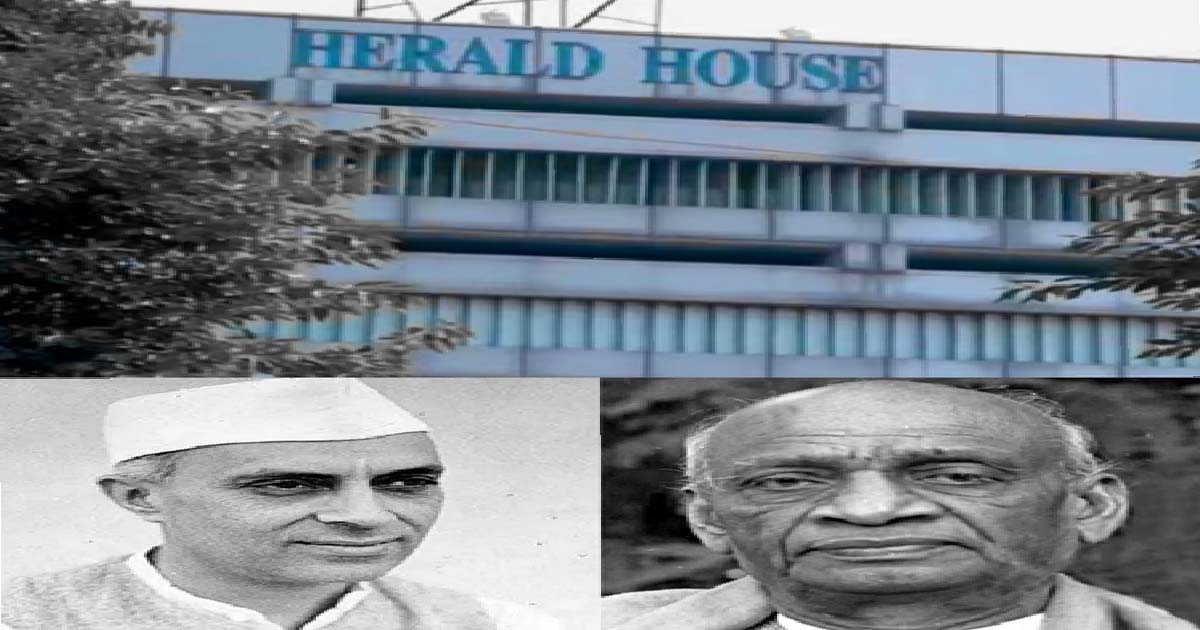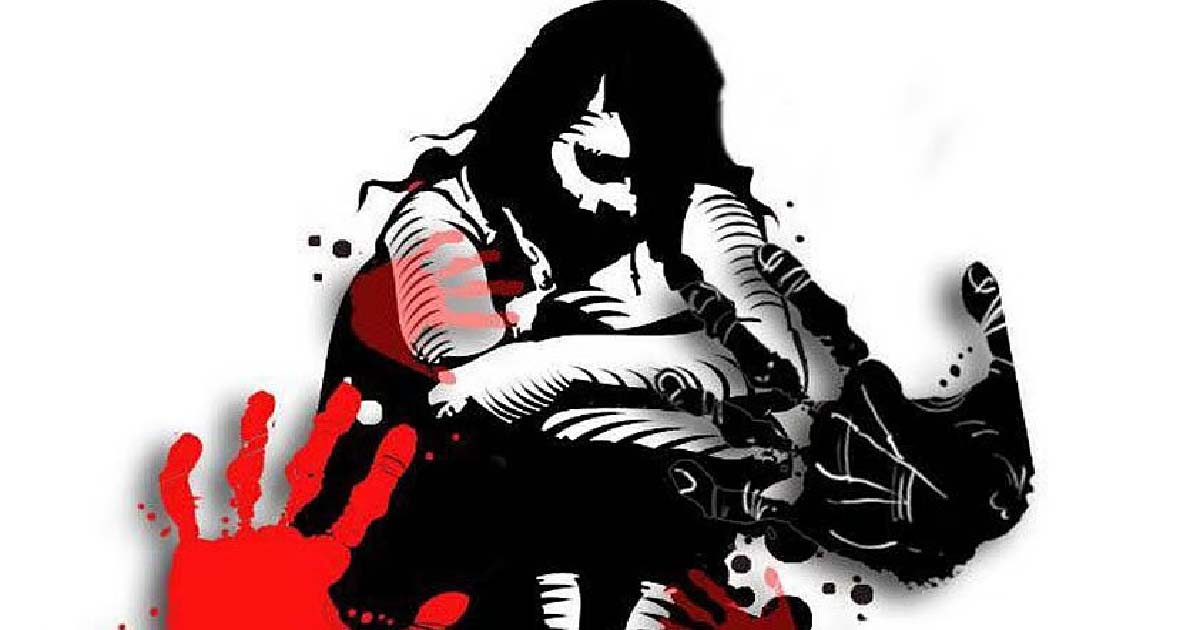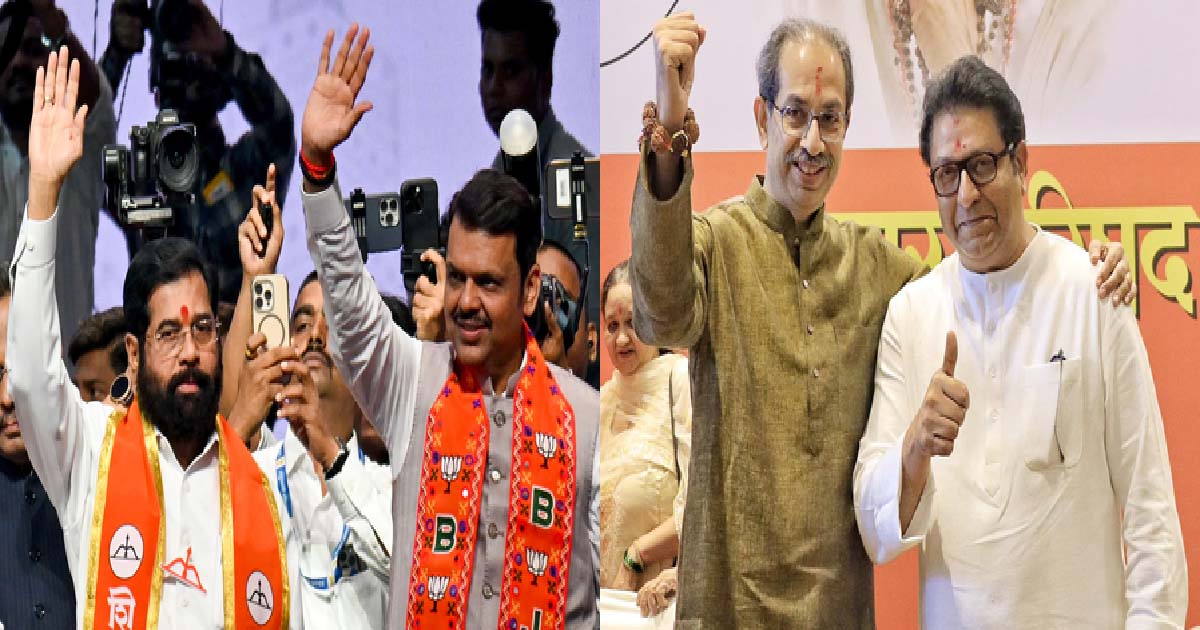National News
Patel’s alarm, Nehru’s ‘dismissal’: The origins of the National Herald storm

New Delhi, April 17: A series of letters exchanged between Sardar Vallabhbhai Patel and Jawaharlal Nehru in May 1950, as documented in the book Sardar Patel’s Correspondence, suggest that Patel expressed concerns to Nehru regarding the use of the ‘National Herald’ for fundraising purposes. These letters indicate that Patel cautioned Nehru about “the potential misuse of government influence in financial dealings” and advised against accepting contributions from “questionable” sources.
The old correspondence between Sardar Patel and Jawaharlal Nehru has resurfaced at the heart of political debate, following the Enforcement Directorate’s chargesheet against former Congress leaders Sonia Gandhi and Rahul Gandhi. The charges, tied to alleged money laundering in the National Herald case, have brought renewed attention to Patel’s early warnings about financial misconduct linked to the publication—warnings that now seem strikingly relevant.
In fact, The National Herald has been entangled in controversy since the early days of independent India. Letters exchanged between Sardar Patel and Jawaharlal Nehru in 1950 are frequently referenced to point out that questions around the paper’s financial conduct and political misuse were being raised even then.
In 1950, Sardar Vallabhbhai Patel explicitly warned Jawaharlal Nehru about dubious fundraising tactics and the ‘misuse’ of government machinery to prop up the National Herald. These serious concerns revealed Patel’s clear discomfort with the ethical and political implications of such actions. Despite the gravity of the warnings, Nehru apparently chose to brush them aside.
Are Sardar Patel’s decades-old warnings proving to be prophetic? The question is echoing across political debates following the Enforcement Directorate’s chargesheet against Sonia and Rahul Gandhi, accusing them of orchestrating a “criminal conspiracy” to usurp properties worth Rs 2,000 crore belonging to Associated Journals Ltd (AJL), the publisher of the National Herald. What began as a stern caution from one of India’s foremost statesmen in 1950 has, according to political analysts referencing Patel’s letters, now spiralled into an allegedly full-blown scandal that “underscores a legacy of alleged misuse of power and political entitlement”.
Sardar Vallabhbhai Patel raised the red flag in a series of pointed letters to Prime Minister Jawaharlal Nehru. On May 5, 1950, Patel wrote to Nehru expressing grave concern over a Rs 75,000 donation to the National Herald from two individuals associated with Himalayan Airways. The airline had reportedly obtained a government contract for night air mail services by circumventing objections from the Indian Air Force. Observers say that it was an early sign of “political favouritism and backroom dealings”.
Patel didn’t mince words. He highlighted that one of the donors, Akhani, was already facing multiple charges of bank fraud. Even more damning was Patel’s accusation that Union Minister Ahmed Kidwai was abusing his official position to collect funds for the Herald, including money from controversial businessmen in Lucknow such as J.P. Srivastava.
Nehru’s reply, sent the same day, was “vague and dismissive”– attempting to pacify Patel without allegedly addressing the core concerns. He mentioned having asked his son-in-law, Feroze Gandhi, then General Manager of the Herald, to look into the matter. According to an analyst, Nehru’s tone as reflected in the letter was non-committal, brushing the issue aside as though it were an unfortunate misunderstanding.
Patel, undeterred, responded the very next day, May 6, 1950. He saw through the deflection as he wrote to Nehru in detail, explaining how certain private companies and their shareholders were involved in the process. Sardar Patel noted, “Some contributions did not come from those involved in running the department. Otherwise, to my knowledge, the number of contributions received was sufficient and involved other individuals as well. The transactions I have referred to are of a different nature. There is no element of charity in them.”
In his follow-up, Nehru again “tried to distance himself from the paper and its finances”, claiming he hadn’t been involved with the National Herald or its fundraising for three years and had passed the responsibility to a woman named Mridula. He admitted “some mistakes may have occurred” but continued to what was seen by many as his attempt to “justify” the questionable transactions as part of a legitimate business proposition, even calling it a matter of “loss and profit” — not charity.
This point was highlighted by BJP national spokesperson Sudhanshu Trivedi who stated that on May 6, 1950, Jawaharlal Nehru wrote a letter to Sardar Patel saying, “Herald is a good business proposition and its preference shares and debentures are not a bad investment.”
It was said during Nehru’s time that the investment made in the National Herald could be profitable. This is a good business investment, so its shares or debentures cannot be considered harmful, said Trivedi referring to correspondence.
The direct implication is that from the very beginning, this investment was linked to profit, business, and property, he added. “Today, the Congress party should be asked this ethical question: when this was always a business plan, how can it suddenly be linked to charity or donations given during the freedom struggle?” he said.
This was the breaking point for Patel.
In his final letter dated May 10, 1950, he made it clear that the issue was about integrity, accountability, and the misuse of political power. As Home Minister, he expressed deep concern over the ‘dishonesty’ surrounding the Herald’s funding and the dubious individuals involved.
He rejected Nehru’s defence outright, calling out the rot at the core of what was being portrayed as a freedom movement legacy.
Sardar Patel wrote, “In light of these events, I do not think there is any benefit in pursuing this matter further. I have already told you how I view these activities, and I doubt that if this happened in any other province and I had any connection to it, I would not accept this situation.”
According to Trivedi, this clearly means that he had become disillusioned and did not want to talk about it again. “Now, Congress should explain what kind of sacrifice and dedication this was,” Trivedi asked.
According to political observers, Patel’s firm stance exposed a deeper malaise — a troubling pattern of entitlement, favouritism, and ethical compromise that would resurface decades later. His warnings, largely ignored at the time, now seem eerily prophetic.
Business
India pushing ahead to diversify exports amid US tariff turmoil: Report

New Delhi, Jan 5: When India reached a free-trade agreement with New Zealand in a record time of nine months towards the end of December, this was a clear signal of New Delhi’s plan to diversify the country’s exports away from the US and this approach is expected to gather pace going ahead, according to an article in the South China Morning Post.
The article highlights that ever since US President Donald Trump imposed penal import tariffs of 50 per cent on India last year, New Delhi has maintained a resolute approach to the punitive levies, even as it has kept the door open to negotiations.
The article points out that the trade deal with New Zealand last month was the third such deal that came close on the heels of the free trade agreements with the United Kingdom and Oman.
The US is India’s largest export market, receiving about 18 per cent of its total goods exports, including items such as garments and leather products, with a vast diaspora readily snapping up products shipped from their homeland.
While it remains unclear whether the two countries can negotiate a trade deal given India’s firm position on opening sensitive sectors such as agriculture and dairy to US products, experts are sceptical that Washington will significantly roll back its tariffs, the article states.
However, it observes that India is not putting all its eggs in the US basket and is actively seeking free trade pacts with other countries to diversify its export markets amid the uncertainty created by the Trump administration.
Commerce Secretary Rajesh Agrawal has already said that India’s effort to diversify trade across geographies and sectors is paying off. There is positive export momentum that is likely to consolidate in the coming months.
The article also highlights that India’s exports in 2025 showed strong resilience and growth, reaching a record US$825.25 billion in the financial year 2024-25. The robust growth has continued into the current financial year, with exports in the April to November period rising 5.43 per cent to US$562.13 billion.
Crime
Thane: 15-Year-Old Girl Abducted, Sexually Assaulted & Forcibly Converted To Islam; Accused Still At Large

Mumbai: A horrifying case has surfaced in Mumbai’s Mira Bhayandar under Valiv police station limits, where a 15-year-old girl fell victim to abduction, forcible religious conversion and sexual assault by a local youth, officials said on Monday.
The accused has been identified as Javed.
The two developed a friendship in their neighbourhood. Javed exploited the friendship by secretly recording her explicit photos and videos, then blackmailing her into accompanying him to Madhya Pradesh.
After the minor was taken to Madhya Pradesh, she was kept there for six months, during which she faced relentless abuse, officials said.
Javed escalated the horror by creating a fake Instagram profile using the girl’s name and photos, posting a rate card for her services per night to auction her online, they added.
According to the information received, Javed also forced her to convert to Islam and attempted to make her eat beef, compounding the trauma for the minor whose father had passed away recently.
She somehow managed to escape from the single room in Madhya Pradesh and came back home to Mumbai.
Following this, she narrated the months of abuse to her family members, who then filed an FIR at the Valiv police station.
Despite the girl filing an FIR at Valiv police station, Javed remains at large.
The victim has said that this has left her terrified as the police have failed to arrest him, and she fears for her life.
Terrified, the victim is now writing a letter to Chief Minister Devendra Fadnavis, seeking urgent intervention in the case.
The police said that they are investigating the case and searching for the accused.
Further details are awaited.
This incident comes at a time when Maharashtra has experienced a continuous, well-planned campaign by Hindutva groups aimed at compelling the state government to implement a strict anti-conversion law, commonly referred to as an ‘anti-love jihad’ law.
National News
Mumbai civic polls: Thackeray cousins’ Marathi pride vs BJP-Shiv Sena’s global city vision

Mumbai, Jan 5: As the Brihanmumbai Municipal Corporation (BMC) elections scheduled for January 15 draw closer, the political contest for Mumbai has sharply intensified.
The Thackeray cousins — Uddhav Thackeray and MNS chief Raj Thackeray — on Sunday released a joint Vachan Nama (manifesto), signalling a rare show of unity. In response, the Bharatiya Janata Party (BJP) unveiled an “Aarop Patra” (charge sheet), alleging large-scale corruption during the Thackeray-led administration’s 25-year control of the BMC.
The Thackeray camp has framed the election around a “Save Democracy” narrative, alleging “vote theft” through unopposed victories and appealing to the idealism of young voters. In contrast, the BJP has launched digital “Aarop” campaigns portraying the existing BMC structure as outdated and corrupt, arguing that it obstructs Mumbai’s transformation into a “Global City” that the youth aspire to.
For the first time in nearly two decades, Shiv Sena (UBT) and the Maharashtra Navnirman Sena (MNS), along with the Nationalist Congress Party (Sharadchandra Pawar), have presented a unified vision for Mumbai under the slogan “Shabd Thackerencha” (word of the Thackerays).
Their manifesto includes a range of welfare promises such as the Swabhiman Nidhi — a monthly allowance of Rs 1,500 for domestic workers and Koli women — construction of one lakh affordable homes within five years, the creation of a dedicated BMC Housing Authority, 100 units of free electricity for residential users through BEST, subsidised meals at Rs 10 for breakfast and lunch, reduction of minimum bus fare to Rs 5, employment allowance and interest-free loans for gig workers, and the establishment of five new medical colleges.
The Vachan Nama also explicitly calls for a “Marathi Mayor” and asserts that Mumbai’s land should primarily be reserved for “Mumbaikars.”
Meanwhile, the BJP’s Aarop Patra alleges a corruption scam amounting to Rs 3 lakh crore over the past 25 years of Thackeray-led governance in the BMC. The party claimed that despite spending Rs 21,000 crore on road construction over a decade, Mumbai continues to suffer from severe pothole issues.
The BJP further alleged irregularities during the COVID-19 pandemic, including the so-called “Body Bag Scam,” where body bags were allegedly procured at Rs 6,721 each despite costing around Rs 1,500, and discrepancies in oxygen plant installations worth Rs 320 crore. It also claimed that approximately 1,700 bar and restaurant owners were subjected to extortion during the Maha Vikas Aghadi tenure.
The BJP accused the Thackeray camp of insincere commitment to the Marathi language, citing a 70 per cent decline in Marathi-medium students and the closure of 114 BMC-run Marathi schools.
While the Thackeray cousins emphasise “Marathi pride,” the BJP maintains that major infrastructure projects such as the Coastal Road and Mumbai Metro were completed only due to the efforts of Chief Minister Devendra Fadnavis and the Centre.
Political observers note that the Thackerays try to build a combined appeal of “social security” and “identity.” By promising a Marathi Mayor and asserting Mumbaikar rights over land, they aim to consolidate the traditional nativist vote that weakened after the Shiv Sena split.
The reunion of Thackerays has also created a strong visual and emotional impact, projecting a “united family” image intended to counter the BJP’s organisational strength. Welfare promises, including free electricity and subsidised meals, are seen as key strategies to attract slum dwellers and chawl residents.
Observers argue that the BJP’s charge sheet strategy is designed to focus on “performance and accountability,” targeting the tax-paying middle class by alleging misuse of public funds under the previous regime. The party is positioning itself as the only force capable of modernising Mumbai, highlighting the rapid execution of infrastructure projects under the current Mahayuti government while contrasting them with what it describes as “25 years of failure.”
-

 Crime3 years ago
Crime3 years agoClass 10 student jumps to death in Jaipur
-

 Maharashtra1 year ago
Maharashtra1 year agoMumbai Local Train Update: Central Railway’s New Timetable Comes Into Effect; Check Full List Of Revised Timings & Stations
-

 Maharashtra1 year ago
Maharashtra1 year agoMumbai To Go Toll-Free Tonight! Maharashtra Govt Announces Complete Toll Waiver For Light Motor Vehicles At All 5 Entry Points Of City
-

 Maharashtra1 year ago
Maharashtra1 year agoFalse photo of Imtiaz Jaleel’s rally, exposing the fooling conspiracy
-

 National News1 year ago
National News1 year agoMinistry of Railways rolls out Special Drive 4.0 with focus on digitisation, cleanliness, inclusiveness and grievance redressal
-

 Maharashtra1 year ago
Maharashtra1 year agoMaharashtra Elections 2024: Mumbai Metro & BEST Services Extended Till Midnight On Voting Day
-

 National News1 year ago
National News1 year agoJ&K: 4 Jawans Killed, 28 Injured After Bus Carrying BSF Personnel For Poll Duty Falls Into Gorge In Budgam; Terrifying Visuals Surface
-

 Crime1 year ago
Crime1 year agoBaba Siddique Murder: Mumbai Police Unable To Get Lawrence Bishnoi Custody Due To Home Ministry Order, Says Report












